

Platform gap fillers are movable platform edge extensions at subway or railway stations where the curvature of the platform creates a significant gap between the platform and subway or train car door.


Platform gap fillers are movable platform edge extensions at subway or railway stations where the curvature of the platform creates a significant gap between the platform and subway or train car door.
Platform gap fillers were trialled on the platforms of Lo Wu station on the East Rail line in 2009 due to the difficulty of installing platform screen doors on the curved nature of the platforms. They were planned to be installed at other stations along the line along with signal upgrades. However, during the trial period, MTR found that the time taken for the gap filler to fully extend took 15-20 seconds and so greatly increased dwell times of trains. It was decided unsuitable for service. After the trial period ended in October 2009, the platform gap fillers were not used until it was finally removed during a platform-strengthening maintenance operation. Plans to install it on other stations of the East Rail line were also abandoned.
Some[ how? ] Japanese railway stations have platform gap fillers, which are known as movable steps (可動ステップ, kadō steppu). [1] Over 200 fillers are used in the Tokyo subway. [2]
With the introduction of the NTfL, Transport for London are hoping to introduce platform gap fillers on the Bakerloo, Central & Piccadilly lines (of which 14 platforms have been identified for installation) at curved platforms such as Bank, where the gap between the train and the platform can exceed 1 foot (30.5 cm). [3]


The Interborough Rapid Transit Company's first cars were built with only two doors on each side, at the extreme ends of the car, lining up with the curved platforms so as not to leave a wide gap between the train and the platform. When the IRT modified existing cars and ordered new cars with a middle door, gap fillers were needed because the middle door was not near the platform. After the City of New York bought the IRT in 1940, new car designs (starting with the R12) had the end doors away from the extreme ends of the car body, which also required the use of gap fillers at certain stations.
IRT stations with gap fillers are:
Platform gap fillers are used in the Mass Rapid Transit system of Singapore, namely the North South MRT line and the East West MRT line. Platform gap fillers are also planned for installation on trains on the North East MRT line and the Circle MRT line as well, because newer trains can be equipped with gap fillers. [8]
Many regional trains in Germany come with platform gap fillers, such as the Bombardier Talent 2. [9] On subway networks, they have also become more common, as evidenced by the Nuremberg U-Bahn whose 1970s first generation VAG Class DT1 do not have them but whose VAG Class DT3 of the 2000s and 2010s and VAG Class G1 of the 2020s come equipped with automatic gap fillers. [10]

A railway platform is an area alongside a railway track providing convenient access to trains. Almost all stations have some form of platform, with larger stations having multiple platforms.

The 42nd Street Shuttle is a New York City Subway shuttle train service that operates in Manhattan. The shuttle is sometimes referred to as the Grand Central/Times Square Shuttle, since these are the only two stations it serves. The shuttle runs at all times except late nights, with trains running on two tracks underneath 42nd Street between Times Square and Grand Central; for many decades, three tracks had been in service until a major renovation was begun in 2019 reducing it to two tracks. With two stations, it is the shortest regular service in the system by number of stops, running about 2,402 feet (732 m) in 90 seconds as of 2005. The shuttle is used by over 100,000 passengers every day, and by up to 10,200 passengers per hour during rush hours.

The Bowling Green station is a station on the IRT Lexington Avenue Line of the New York City Subway, located at Broadway and Battery Place, in the Financial District of Manhattan. It is served by the 4 train at all times and the 5 train at all times except late nights.
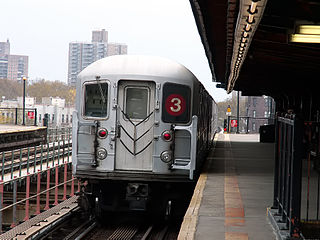
The Sutter Avenue–Rutland Road station is a station on the IRT New Lots Line of the New York City Subway, located at the intersection of Sutter Avenue, Rutland Road, and East 98th Street at the border of East Flatbush and Brownsville, Brooklyn. It is served by the 3 train at all times except late nights, when the 4 train takes over service. During rush hours, occasional 2, 4 and 5 trains also stop here.

The 174th Street station is a local station on the IRT White Plains Road Line of the New York City Subway. Located at the intersection of 174th Street, Southern Boulevard and Boston Road in the Crotona Park East neighborhood of the Bronx, it is served by the 2 train at all times, and the 5 train at all times except late nights and rush hours in the peak direction.

The Times Square–42nd Street station is a major New York City Subway station complex located under Times Square, at the intersection of 42nd Street, Seventh Avenue, and Broadway, in Midtown Manhattan. The complex allows free transfers between the IRT 42nd Street Shuttle, the BMT Broadway Line, the IRT Broadway–Seventh Avenue Line and the IRT Flushing Line, as well as to the IND Eighth Avenue Line a block west at 42nd Street–Port Authority Bus Terminal. The complex is served by the 1, 2, 3, 7, N and Q trains at all times, the W train during weekdays; the R and 42nd Street Shuttle (S) trains at all times except late nights; and <7> trains during rush hours in the peak direction. A free passageway from the shuttle platform to the 42nd Street–Bryant Park/Fifth Avenue station, served by the 7, <7>, B, D, F, <F>, and M trains, is open during the day from 6 a.m. to 12 a.m.
The IRT Broadway–Seventh Avenue Line is a New York City Subway line. It is one of several lines that serves the A Division, stretching from South Ferry in Lower Manhattan north to Van Cortlandt Park–242nd Street in Riverdale, Bronx. The Brooklyn Branch, known as the Wall and William Streets Branch during construction, from the main line at Chambers Street southeast through the Clark Street Tunnel to Borough Hall in Downtown Brooklyn, is also part of the Broadway–Seventh Avenue Line. The IRT Broadway–Seventh Avenue Line is the only line to have elevated stations in Manhattan, with two short stretches of elevated track at 125th Street and between Dyckman and 225th Streets.

The Grand Central–42nd Street station is a major station complex of the New York City Subway. Located in Midtown Manhattan at 42nd Street between Madison and Lexington Avenues, it serves trains on the IRT Lexington Avenue Line, the IRT Flushing Line and the 42nd Street Shuttle. The complex is served by the 4, 6, and 7 trains at all times; the 5 and 42nd Street Shuttle (S) trains at all times except late nights; the <6> train during weekdays in the peak direction; and the <7> train during rush hours and early evenings in the peak direction.
The IRT Lexington Avenue Line is one of the lines of the A Division of the New York City Subway, stretching from Lower Manhattan north to 125th Street in East Harlem. The line is served by the 4, 5, 6, and <6> trains.

The New York City Subway is a rapid transit system that serves four of the five boroughs of New York City, New York: the Bronx, Brooklyn, Manhattan, and Queens. Its operator is the New York City Transit Authority (NYCTA), which is controlled by the Metropolitan Transportation Authority (MTA) of New York. In 2016, an average of 5.66 million passengers used the system daily, making it the busiest rapid transit system in the United States and the seventh busiest in the world.
The IRT Dyre Avenue Line is a New York City Subway rapid transit line, part of the A Division. It is a branch of the IRT White Plains Road Line in the northeastern section of the Bronx, north of East 180th Street. As of 2013, it has a daily ridership of 34,802.
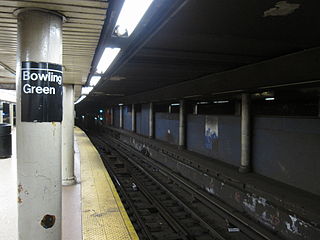
The Bowling Green–South Ferry shuttle was a shuttle service of the New York City Subway system that operated between Bowling Green and the inner loop platform at South Ferry. It operated to provide South Ferry service for IRT Lexington Avenue Line riders during hours when the 5 service did not stop at South Ferry. Because the inner loop station that the shuttle used at the South Ferry station was on such a tight curve, there was no continuous platform; instead four openings in the tunnel wall led into the station. Four R12 cars that were used on the shuttle, 5703–5706, which were modified and equipped so that only the center door of each car would open at one of the open spaces.
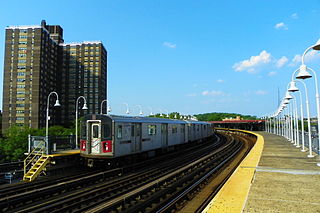
The White Plains Road Line is a rapid transit line of the A Division of the New York City Subway serving the central Bronx. It is mostly elevated and served both subway and elevated trains until 1952. The original part of the line, the part opened as part of the first subway was called the West Farms Division, and the extension north to 241st Street as part of the Dual Contracts was called the White Plains Road Line. Eventually, however, the two parts came to be known as the White Plains Road Line.

The Chambers Street station is an express station on the IRT Broadway–Seventh Avenue Line of the New York City Subway, located at the intersection of Chambers Street and West Broadway in Lower Manhattan. It is served by the 1 and 2 trains at all times, and by the 3 train at all times except late nights.

Platform screen doors (PSDs), also known as platform edge doors (PEDs), are used at some train, rapid transit and people mover stations to separate the platform from train tracks, as well as on some bus rapid transit, tram and light rail systems. Primarily used for passenger safety, they are a relatively new addition to many metro systems around the world, some having been retrofitted to established systems. They are widely used in newer Asian and European metro systems, and Latin American bus rapid transit systems.
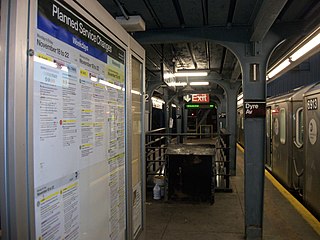
The Eastchester–Dyre Avenue station is the northern terminal station of the IRT Dyre Avenue Line of the New York City Subway, at Dyre Avenue and Light Street in the Eastchester neighborhood of the Bronx. It is served by the 5 train at all times.

The South Ferry/Whitehall Street station is a New York City Subway station complex in the Financial District neighborhood of Manhattan, under Battery Park. The complex is shared by the IRT Broadway–Seventh Avenue Line and the BMT Broadway Line. It is served by the 1 and R trains at all times, the W train only on weekdays during the day, and the N train at night.

The Brooklyn Bridge–City Hall/Chambers Street station is a New York City Subway station complex in Lower Manhattan. The complex is served by trains of the IRT Lexington Avenue Line and the BMT Nassau Street Line. The station is served by the 4, 6, and J trains at all times; the 5 train at all times except late nights; the <6> train during weekdays in the peak direction; and the Z train during rush hours in the peak direction.
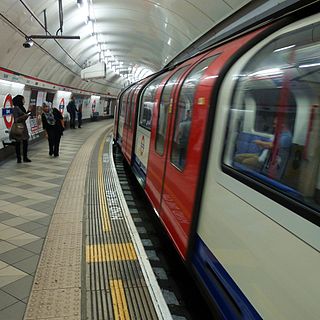
A platform gap is the space between a train car and the edge of the station platform, often created by geometric constraints, historic legacies, or use of partially compatible equipment.
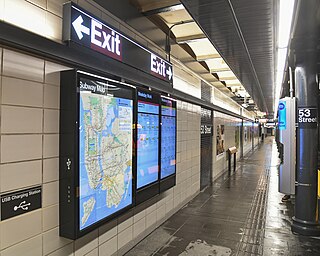
Since the late 20th century, the Metropolitan Transportation Authority has started several projects to maintain and improve the New York City Subway. Some of these projects, such as subway line automation, proposed platform screen doors, the FASTRACK maintenance program, and infrastructural improvements proposed in 2015–2019 Capital Program, contribute toward improving the system's efficiency. Others, such as train-arrival "countdown clocks", "Help Point" station intercoms, "On the Go! Travel Station" passenger kiosks, wireless and cellular network connections in stations, MetroCard fare payment alternatives, and digital ads, are meant to benefit individual passengers. Yet others, including the various methods of subway construction, do not directly impact the passenger interface, but are used to make subway operations efficient.